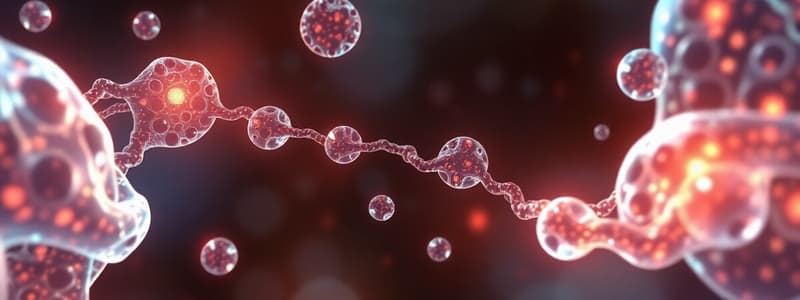Podcast
Questions and Answers
What physiological factor, when significantly reduced, would most likely lead to decreased drug absorption, especially in the context of oral administration?
What physiological factor, when significantly reduced, would most likely lead to decreased drug absorption, especially in the context of oral administration?
- Reduced intestinal blood flow (correct)
- Elevated body temperature
- Increased gastric acidity
- Enhanced microvilli motility
A patient with severe diarrhea may experience reduced drug efficacy due to which altered pharmacokinetic process?
A patient with severe diarrhea may experience reduced drug efficacy due to which altered pharmacokinetic process?
- Reduced contact time in the GI tract (correct)
- Increased first-pass metabolism
- Increased plasma protein binding
- Enhanced drug solubility
An orally administered drug has a bioavailability (F) of 0.6. What does this indicate regarding the drug's absorption and systemic availability?
An orally administered drug has a bioavailability (F) of 0.6. What does this indicate regarding the drug's absorption and systemic availability?
- 60% of the administered dose is chemically unstable and degrades in the GI tract.
- 40% of the drug is immediately excreted renally.
- The drug undergoes 40% metabolism in the intestinal lumen prior to absorption.
- 60% of the administered dose reaches systemic circulation unchanged. (correct)
In the context of drug absorption, what is the primary significance of comparing the area under the curve (AUC) of a drug administered intravenously versus orally?
In the context of drug absorption, what is the primary significance of comparing the area under the curve (AUC) of a drug administered intravenously versus orally?
Which scenario would result in a prolonged lag time before a drug's effects are observed?
Which scenario would result in a prolonged lag time before a drug's effects are observed?
What is the most accurate interpretation of the 'onset of activity' in the context of plasma drug concentration curves?
What is the most accurate interpretation of the 'onset of activity' in the context of plasma drug concentration curves?
Capillary permeability significantly affects drug distribution. What characteristic of liver and spleen capillaries facilitates the passage of larger molecules and plasma proteins compared to brain capillaries?
Capillary permeability significantly affects drug distribution. What characteristic of liver and spleen capillaries facilitates the passage of larger molecules and plasma proteins compared to brain capillaries?
A highly lipophilic drug is administered intravenously. Which factor would most significantly affect its initial distribution into tissues?
A highly lipophilic drug is administered intravenously. Which factor would most significantly affect its initial distribution into tissues?
A drug has a small volume of distribution. What is the pharmacological implication of this?
A drug has a small volume of distribution. What is the pharmacological implication of this?
A drug that is extensively sequestered in tissues is more likely to exhibit:
A drug that is extensively sequestered in tissues is more likely to exhibit:
A patient receives an initial dose of a lipophilic drug that rapidly enters the brain, producing anesthesia. However, the anesthetic effect diminishes quickly despite the drug's long half-life. What is the most likely cause of this?
A patient receives an initial dose of a lipophilic drug that rapidly enters the brain, producing anesthesia. However, the anesthetic effect diminishes quickly despite the drug's long half-life. What is the most likely cause of this?
If a drug has a volume of distribution of 500 liters in a 70 kg individual, what does this suggest about the drug's distribution?
If a drug has a volume of distribution of 500 liters in a 70 kg individual, what does this suggest about the drug's distribution?
A drug has a volume of distribution of 100L. If the desired plasma concentration is 2 mg/L for a 50 kg patient, then what is the required dose (in mg)?
A drug has a volume of distribution of 100L. If the desired plasma concentration is 2 mg/L for a 50 kg patient, then what is the required dose (in mg)?
A patient with heart failure is prescribed digoxin. Their current digoxin level is 0.8 mcg/L, but the target level is 1.5 mcg/L. Given digoxin's volume of distribution is 5 L/kg, how much additional digoxin should a 70-kg patient receive (in mcg)?
A patient with heart failure is prescribed digoxin. Their current digoxin level is 0.8 mcg/L, but the target level is 1.5 mcg/L. Given digoxin's volume of distribution is 5 L/kg, how much additional digoxin should a 70-kg patient receive (in mcg)?
Why should tetracycline and heavy metals be avoided during pregnancy?
Why should tetracycline and heavy metals be avoided during pregnancy?
Flashcards
Bioavailability (F)
Bioavailability (F)
Fraction of administered drug reaching systemic circulation.
Lag Time
Lag Time
Time from drug administration to appearance in blood.
Onset of Activity
Onset of Activity
Time from administration to minimum effective concentration (MEC).
Duration of Action
Duration of Action
Signup and view all the flashcards
Volume of Distribution (Vd)
Volume of Distribution (Vd)
Signup and view all the flashcards
Redistribution of Lipid-Soluble Drugs
Redistribution of Lipid-Soluble Drugs
Signup and view all the flashcards
Drug Absorption
Drug Absorption
Signup and view all the flashcards
Bound Drug
Bound Drug
Signup and view all the flashcards
Placental Transfer
Placental Transfer
Signup and view all the flashcards
High Volume of Distribution (Vd)
High Volume of Distribution (Vd)
Signup and view all the flashcards
Food effect on absorption rates
Food effect on absorption rates
Signup and view all the flashcards
Minimum Effective Concentration (MEC)
Minimum Effective Concentration (MEC)
Signup and view all the flashcards
Study Notes
Drug Absorption & Key Terms
- The material focuses on drug absorption, related terms, and influencing factors.
- The goal is to describe terms related to drug absorption, how bioavailability is affected, and how plasma drug correlates to absorption and elimination.
Factors Affecting Drug Absorption
- Blood flow to the absorption site influences drug uptake.
- Intestinal blood flow exceeds stomach blood flow.
- Reduced blood flow decreases absorption.
- Total surface area impacts absorption efficiency.
- Intestinal microvilli greatly increase surface area versus the stomach
- Contact time determines absorption duration
- Less time due to faster GI movement results in less absorbed drug.
- Delayed gastric empyting due to food, distress, exercise and sympathetic input decreases absorption.
Bioavailability (F)
- Bioavailability is the fraction of a drug dose reaching systemic circulation, labeled as F.
- Intravenous (IV) administration yields 100% bioavailability.
- Other routes result in F < 100% due to losses.
- First-pass metabolism, poor solubility, and chemical instability can reduce F.
Bioavailability and IV Administration
- IV administration is the bioavailability standard at 100%.
- Area Under the Curve (AUC) is used to compare routes. For example, oral vs IV.
- Oral bioavailability is typically lower than IV.
Two-Compartment Model
- Absorption involves drug placement (compartment 1) and movement to blood (compartment 2).
- IV administration is a one-compartment model.
- Intramuscular (IM) administration involves drug movement from muscle (compartment 1) to blood (compartment 2).
Factors Affecting Absorption Rates
- Food in the stomach and renal dysfunction can alter drug absorption.
- Food can delay absorption.
- Renal dysfunction impairs drug elimination, extending action duration.
Key Drug Absorption Terms
- Lag Time: Time from administration to drug appearance in the blood.
- Onset of Activity: Time until plasma levels reach MEC, initiating drug action.
- Minimum Effective Concentration is (MEC).
- Duration of Action: Time plasma levels stay above MEC.
Understanding Plasma Level Curves
- These plot time vs. plasma concentration showing drug absorption, peak, and elimination.
- Oral administration shows a gradual increase.
- Intravenous (IV) administration starts high and declines immediately.
Determinants of Drug Distribution
- Organ size, blood flow, capillary permeability, and binding to plasma proteins influence drug distribution.
- Size and blood flow also determines drug effect duration
- Fenestrations in endothelial cells allow drugs to move more readily in the tiver, spleen
- The blood brain barrier makes it more difficult for drugs to enter
Drug Binding & Volume of Distribution
- Drug binding affects distribution.
- Lipid-soluble drugs need carriers.
- Albumin serves as the primary binding protein.
- Bound drugs are inactive; free drugs are active
- Volume of Distribution (Vd) is the hypothetical volume of drug dissemination.
Calculating Volume of Distribution
- The formula is Vd = Amount of drug in the body / Plasma concentration.
- High Vd means greater tissue penetration.
- Low Vd means more drug stays in the plasma.
- Vd can exceed body fluid volume with extensive tissue distribution.
Redistribution Process
- Lipid-soluble drugs redistribute into fat after initial distribution to organs (e.g., brain).
- Redistribution rate affects drug duration more than half-life.
- Repeated doses can saturate fat, prolonging effects. Example: Thiopental.
Utilizing Volume of Distribution
- Knowledge of Vd and plasma concentrations allows dose calculations.
Volume of Distribution and Drug Concentrations
- C₀, initial plasma concentration, is critical for calculation.
- Formula: Vd = Amount of drug / Plasma concentration (C₀).
- Large Vd causes greater sequestration of tissues and a longer half life.
Drug Reservoirs
- Plasma protein binding can occur.
- Most drugs bind to proteins.
- Acidic drugs bind albumin; basic drugs bind alpha-1 acid glycoproteins.
- Only unbound drugs are active.
- Cellular reservoirs, Muscle and fat tissues can store drugs.
Placental Transfer
- Most drugs cross via simple passive diffusion.
- Lipid-soluble, non-ionized drugs cross readily.
- Water-soluble, large, highly-bound drugs cross less efficiently.
- The placenta is not a barrier; most drugs reach the fetus, causing exposure to the maternal drugs.
Studying That Suits You
Use AI to generate personalized quizzes and flashcards to suit your learning preferences.




